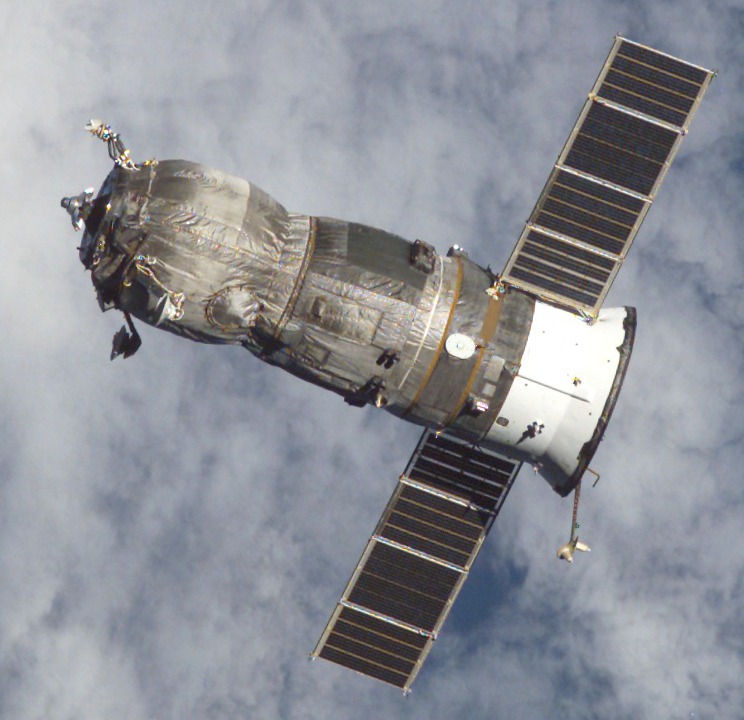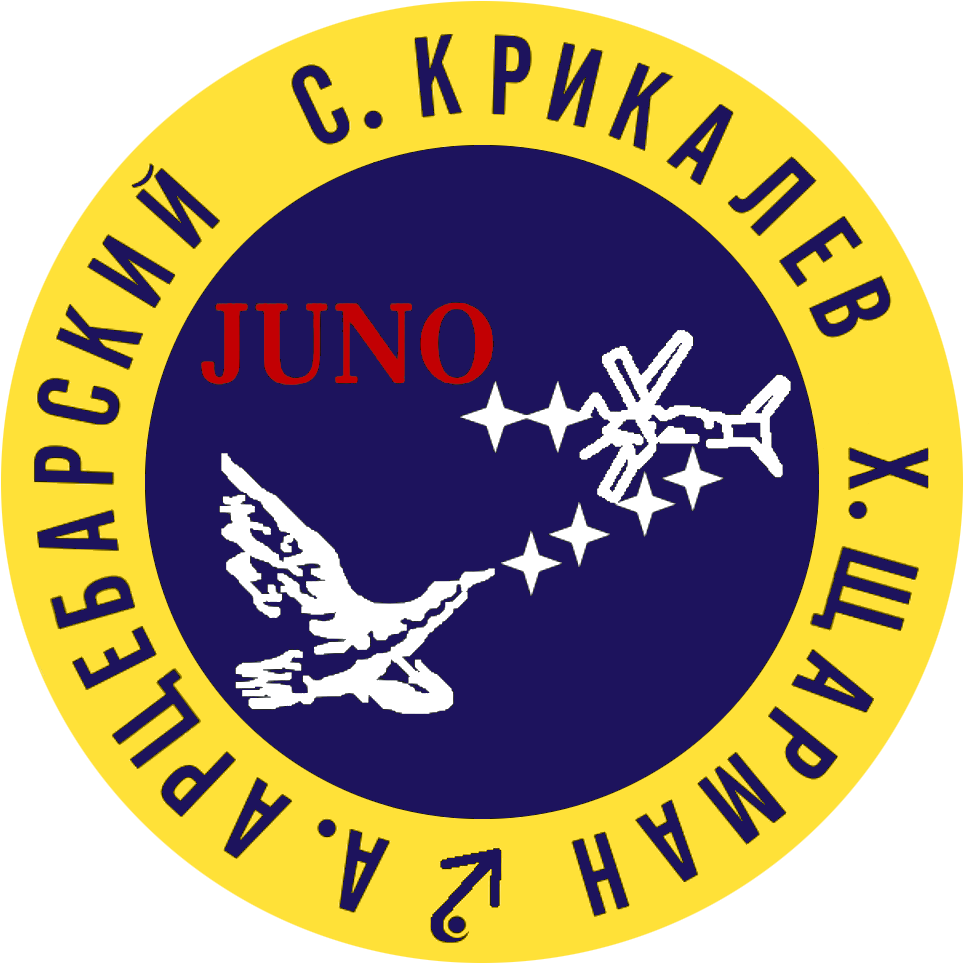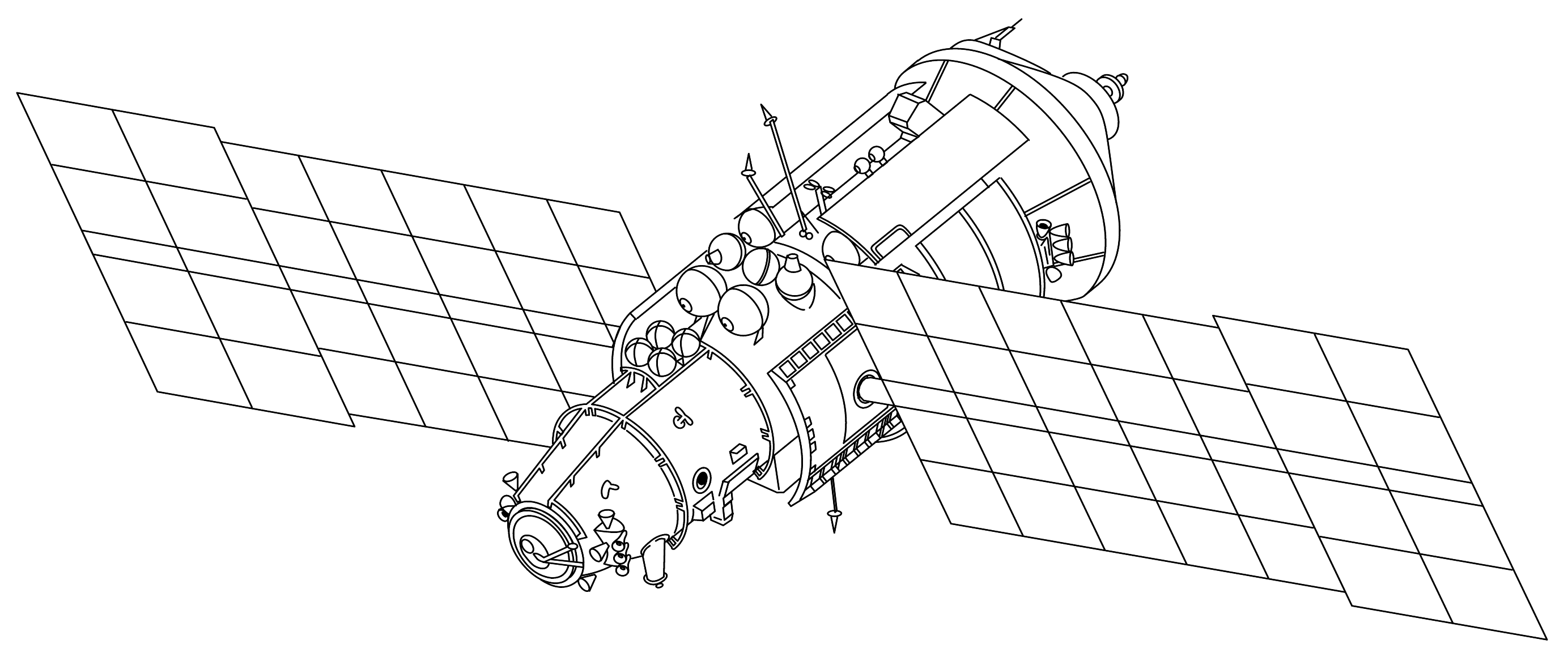|
Mir EO-8
Mir EO-8 (russian: Мир ЭО-19) was the eighth crewed expedition to the space station Mir, lasting from December 1990 to May 1991. The crew, consisting of Russian cosmonauts Viktor Afanasyev and Musa Manarov, launched along with space journalist Toyohiro Akiyama on December 2, 1990 aboard Soyuz TM-11. Akiyama returned aboard Soyuz TM-10 with the outgoing Mir EO-7 crew on December 10. Afanasyev and Manarov returned aboard Soyuz TM-11 on May 26, 1991. Crew Mir EO-8 was the first spaceflight for Commander Viktor Afanasyev, who completed basic training in 1987 and advanced training in 1988. He served as backup commander for Mir EO-7. EO-8 was Musa Manarov's second spaceflight. He previously flew on Soyuz TM-4, living on Mir from December 21, 1987, to December 21, 1988. Both spent just over 175 days in space and completed 2770 orbits of the Earth during EO-8. Backup crew Mission highlights Crew launch and arrival The crew of Mir EO-8 was launched to the Mir space statio ... [...More Info...] [...Related Items...] OR: [Wikipedia] [Google] [Baidu] |
Viktor Mikhailovich Afanasyev
Viktor Mikhailovich Afanasyev (russian: Виктор Михайлович Афанасьев; born 31 December 1948) is a colonel in the Russian Air Force and a test cosmonaut of the Yu. A. Gagarin Cosmonaut Training Center. He was born 31 December 1948, in Bryansk, Russian SFSR, and is married to Yelena Ya. Afanasyeva, born in 1952. They have two children. His father, Mikhail Z. Afanasyev, is deceased. His mother, Marya S. Afanasyeva, resides in Merkulyevo, Bryansk region, Russia. His recreational interests include football, swimming, and tourism. He considers his favorite meal to be borscht. Education Graduated from Kachynskoye Military Pilot School in 1970 and the Ordzhonikidze Aviation Institute, Moscow, in 1980. Special honors Hero of the Soviet Union; Pilot-Cosmonaut of the USSR. Experience 1970 to 1976 served in the Air Force fighting troops as a pilot, senior pilot, and aircraft flight commander. 1976 to 1977 attended the Test Pilot Training Center. 1977 to ... [...More Info...] [...Related Items...] OR: [Wikipedia] [Google] [Baidu] |
Progress-M
Progress-M (russian: Прогресс-М, GRAU indices 11F615A55 and 11F615A60), also known as Progress 7K-TGM, is a Russian, previously Soviet spacecraft which is used to resupply space stations. It is a variant of the Progress spacecraft, originally built in the late 1980s as a modernised version of the Progress 7K-TG spacecraft, using new systems developed for the Soyuz-T and Soyuz-TM spacecraft. The 11F61560 variant incorporated further modernisation, with digital flight control systems replacing the earlier analogue ones. The older 11F615A55 spacecraft outlived the newer 11F615A60. The final Progress-M, Progress-M-UM, was launched on 24 November 2021. The first forty three Progress-M spacecraft were used to resupply Mir, with subsequent spacecraft flying to the International Space Station. , eighty seven spacecraft have been launched, with sixty seven using the older model, and twenty using the newer version. Launches of the 11F615A60 are continuing. One 11F615A60, Prog ... [...More Info...] [...Related Items...] OR: [Wikipedia] [Google] [Baidu] |
Coordinated Universal Time
Coordinated Universal Time or UTC is the primary time standard by which the world regulates clocks and time. It is within about one second of mean solar time (such as UT1) at 0° longitude (at the IERS Reference Meridian as the currently used prime meridian) and is not adjusted for daylight saving time. It is effectively a successor to Greenwich Mean Time (GMT). The coordination of time and frequency transmissions around the world began on 1 January 1960. UTC was first officially adopted as CCIR Recommendation 374, ''Standard-Frequency and Time-Signal Emissions'', in 1963, but the official abbreviation of UTC and the official English name of Coordinated Universal Time (along with the French equivalent) were not adopted until 1967. The system has been adjusted several times, including a brief period during which the time-coordination radio signals broadcast both UTC and "Stepped Atomic Time (SAT)" before a new UTC was adopted in 1970 and implemented in 1972. This change also ... [...More Info...] [...Related Items...] OR: [Wikipedia] [Google] [Baidu] |
Soyuz TM-12
Soyuz TM-12 was the 12th expedition to Mir, and included the first Briton in space,The mission report is available here: http://www.spacefacts.de/mission/english/soyuz-tm12.htm Helen Sharman. Crew Mission highlights The Mir crew welcomed aboard Anatoli Artsebarski, Sergei Krikalev (on his second visit to the station), and British cosmonaut-researcher Helen Sharman, who was aboard as part of Project Juno, a cooperative venture partly sponsored by British private enterprise. Sharman's experimental program, which was designed by the Soviets, leaned heavily toward life sciences, her speciality being chemistry. A bag of 250,000 pansy seeds was placed in the Kvant-2 EVA airlock, a compartment not as protected from cosmic radiation as other Mir compartments. Sharman also contacted nine British schools by radio and conducted high-temperature superconductor experiments with the Elektropograph-7K device. Sharman commented that she had difficulty finding equipment on Mir as there was a ... [...More Info...] [...Related Items...] OR: [Wikipedia] [Google] [Baidu] |
Project Juno
Project Juno was a privately funded campaign which selected Helen Sharman to be the first Briton in space. As the United Kingdom did not, at that time, have a human spaceflight programme (until the UK joined the human spaceflight elements of ESA's exploration programme in December 2012, which led to Tim Peake's ESA mission in 2015), a private consortium was formed to raise money to pay the Soviet Union for a seat on a Soyuz mission to the Mir space station. The Soviet Union had recently flown Toyohiro Akiyama, a Japanese journalist, under a similar arrangement. Selection A call for applicants was publicized in the UK (one ad read "Astronaut wanted. No experience necessary"), leading to 13,000 applications. Juno selected four candidates to train in the Soviet Union: * Gordon Brooks (Royal Navy physician, then 33) * Major Timothy Mace ( Army Air Corps, 33) * Clive Smith (Kingston University lecturer, 27) * Helen Sharman (food technologist, 26) Eventually Mace and Sharman we ... [...More Info...] [...Related Items...] OR: [Wikipedia] [Google] [Baidu] |
Helen Sharman
Helen Patricia Sharman, CMG, OBE, HonFRSC (born 30 May 1963) is a British chemist and cosmonaut who became the first British person, first Western European woman and first privately funded woman in space, as well as the first woman to visit the '' Mir'' space station, in May 1991. Early life and education Sharman was born in Grenoside, Sheffield, where she attended Grenoside Junior and Infant School, later moving to Greenhill. After studying at Jordanthorpe Comprehensive, she obtained a BSc degree in chemistry at the University of Sheffield in 1984 and a PhD degree from Birkbeck, the University of London in 1987. She worked as a research and development technologist for GEC in London and later as a chemist for Mars dealing with the flavouring properties of chocolate. This later led the UK press to label her "The Girl from Mars". Project Juno After responding to a radio advertisement asking for applicants to be the first British space explorer, Helen Sharman wa ... [...More Info...] [...Related Items...] OR: [Wikipedia] [Google] [Baidu] |
Great Britain
Great Britain is an island in the North Atlantic Ocean off the northwest coast of continental Europe. With an area of , it is the largest of the British Isles, the largest European island and the ninth-largest island in the world. It is dominated by a maritime climate with narrow temperature differences between seasons. The 60% smaller island of Ireland is to the west—these islands, along with over 1,000 smaller surrounding islands and named substantial rocks, form the British Isles archipelago. Connected to mainland Europe until 9,000 years ago by a landbridge now known as Doggerland, Great Britain has been inhabited by modern humans for around 30,000 years. In 2011, it had a population of about , making it the world's third-most-populous island after Java in Indonesia and Honshu in Japan. The term "Great Britain" is often used to refer to England, Scotland and Wales, including their component adjoining islands. Great Britain and Northern Ireland now cons ... [...More Info...] [...Related Items...] OR: [Wikipedia] [Google] [Baidu] |
Progress M-7
Progress M-7 (russian: Прогресс М-7, italic=yes) was a Soviet uncrewed cargo spacecraft which was launched in 1991 to resupply the Mir space station. The twenty-fifth of sixty four Progress spacecraft to visit Mir, it used the Progress-M 11F615A55 configuration, and had the serial number 208. It carried supplies including food, water and oxygen for the EO-8 crew aboard Mir, as well as equipment for conducting scientific research, and fuel for adjusting the station's orbit and performing manoeuvres. It also carried the second VBK-Raduga capsule, intended to return equipment and experiment results to Earth. Progress M-7 was launched at 13:05:15 GMT on 19 March 1991, atop a Soyuz-U2 carrier rocket flying from Site 1/5 at the Baikonur Cosmodrome. It took three attempts to dock with Mir; the first of which occurred at 14:28 GMT on 21 March, and resulted in Progress M-7 approaching to within of Mir, before the attempt was aborted. During a second attempt on 23 March, approach ... [...More Info...] [...Related Items...] OR: [Wikipedia] [Google] [Baidu] |
Gulf War
The Gulf War was a 1990–1991 armed campaign waged by a Coalition of the Gulf War, 35-country military coalition in response to the Iraqi invasion of Kuwait. Spearheaded by the United States, the coalition's efforts against Ba'athist Iraq, Iraq were carried out in two key phases: Operation Desert Shield, which marked the military buildup from August 1990 to January 1991; and Operation Desert Storm, which began with the Gulf War air campaign, aerial bombing campaign against Iraq on 17 January 1991 and came to a close with the American-led Liberation of Kuwait campaign, Liberation of Kuwait on 28 February 1991. On 2 August 1990, Iraq invaded the neighbouring Kuwait, State of Kuwait and had fully occupied the country within two days. Initially, Iraq ran the occupied territory under a puppet government known as the "Republic of Kuwait" before proceeding with an outright annexation in which Kuwaiti sovereign territory was split, with the "Saddamiyat al-Mitla' District" being car ... [...More Info...] [...Related Items...] OR: [Wikipedia] [Google] [Baidu] |
Persian Gulf
The Persian Gulf ( fa, خلیج فارس, translit=xalij-e fârs, lit=Gulf of Fars, ), sometimes called the ( ar, اَلْخَلِيْجُ ٱلْعَرَبِيُّ, Al-Khalīj al-ˁArabī), is a mediterranean sea in Western Asia. The body of water is an extension of the Indian Ocean located between Iran and the Arabian Peninsula.United Nations Group of Experts on Geographical NameWorking Paper No. 61, 23rd Session, Vienna, 28 March – 4 April 2006. accessed October 9, 2010 It is connected to the Gulf of Oman in the east by the Strait of Hormuz. The Shatt al-Arab river delta forms the northwest shoreline. The Persian Gulf has many fishing grounds, extensive reefs (mostly rocky, but also coral), and abundant pearl oysters, however its ecology has been damaged by industrialization and oil spills. The Persian Gulf is in the Persian Gulf Basin, which is of Cenozoic origin and related to the subduction of the Arabian Plate under the Zagros Mountains. The current f ... [...More Info...] [...Related Items...] OR: [Wikipedia] [Google] [Baidu] |
Kvant-1
Kvant-1 (russian: Квант-1; English: Quantum-I/1) (37KE) was the first module to be attached in 1987 to the Mir Core Module, which formed the core of the Soviet space station ''Mir''. It remained attached to ''Mir'' until the entire space station was deorbited in 2001. The Kvant-1 module contained scientific instruments for astrophysical observations and materials science experiments. It was used to conduct research into the physics of active galaxies, quasars and neutron stars and it was uniquely positioned for studies of the Supernova SN 1987A. Furthermore, it supported biotechnology experiments in anti-viral preparations and fractions. Some additions to Kvant-1 during its lifetime were solar arrays and the ''Sofora'' and ''Rapana'' girders. The Kvant-1 module was based on the TKS spacecraft and was the first, experimental version of a planned series of '37K' type modules. The 37K modules featured a jettisonable TKS-E type propulsion module, also called the Functional Serv ... [...More Info...] [...Related Items...] OR: [Wikipedia] [Google] [Baidu] |
Kvant-2
Kvant-2 (russian: Квант-2; English: Quantum-II/2) (77KSD, TsM-D, 11F77D) was the third module and second major addition to the Mir space station. Its primary purpose was to deliver new science experiments, better life support systems, and an airlock to Mir. It was launched on November 26, 1989 on a Proton rocket. It docked to Mir on December 6. Its control system was designed by the NPO "Electropribor" (Kharkiv, Ukraine). Description Kvant-2 was the first Mir module based on the TKS spacecraft (77k module). Kvant-2 was divided into three compartments. They were the EVA airlock, the instrument/cargo compartment, and the instrument/experiment compartment. The instrument/cargo compartment could be sealed off and act as an extension or a back-up to the airlock. Before Kvant-2 docked to the station, EVAs had to be carried by depressurizing the docking node on the Core Module. Kvant-2 also carried the Soviet version of the Manned Maneuvering Unit for the Orlan space suit. It ... [...More Info...] [...Related Items...] OR: [Wikipedia] [Google] [Baidu] |








